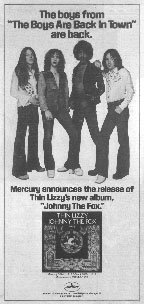![]()
  |

Johnny the Fox
Thin Lizzy
Mercury SRM-1-1119
Released: November 1976
Chart Peak: #52
Weeks Charted: 11
 A burst of machine-gun snares settles into a funky beat that is jolted by a squeal of wah-wah guitar and the cry of "Johnny the Fox!" from bassist Phil Lynott. And then, employing an irresistible rhythm lick, the twin guitars of Brian Robertson and Scot Gorham set into motion the hard-rock machine that has established Thin Lizzy as a prime manipulator of mid-Seventies hard rock. Like Cocky Rocky, this album's archetypal rock & roll star, Thin Lizzy knows all the moves.
A burst of machine-gun snares settles into a funky beat that is jolted by a squeal of wah-wah guitar and the cry of "Johnny the Fox!" from bassist Phil Lynott. And then, employing an irresistible rhythm lick, the twin guitars of Brian Robertson and Scot Gorham set into motion the hard-rock machine that has established Thin Lizzy as a prime manipulator of mid-Seventies hard rock. Like Cocky Rocky, this album's archetypal rock & roll star, Thin Lizzy knows all the moves.
Thin Lizzy's strength lies in a thorough digestion of influences -- the Who, the Stones and Jimi Hendrix -- that has given them an organic cohesion. John Alcock's production is muddy in the British rock tradition when compared to the streamlined and steely technique Jack Douglas uses with Aerosmith, and in this sense Lizzy re-creates rather than recasts the combustible energy of their forefathers. Obviously, being British doesn't hurt.
 Click image for larger view. |
Lynott's lyrics have similarly overcome the pedestrian gaffes that flawed his work on Jailbreak. And yet, while both his lyrics and music have improved, it's more a process of refinement than a movement toward a more unique style. Lynott and Thin Lizzy have crafted their rock & roll attack to the point where they must branch out stylistically or indefinitely repeat themselves.
Johnny the Fox's lyrics revolve around violence and rock & roll. "Johnny" is a bone-crunching rocker with lyrics to match: Johnny has robbed a drugstore and shot the guard "to fill a daily need" and is now holed up in an alleyway with a gun. What is disturbing about the song is its narrative superficiality -- the lyrics neither explain nor question his violent tendencies. Consequently, they provoke little response -- while Lynott lays out the odds of emerging from the alley alive, we hardly care if he gets shot in the head.
Like Aerosmith's Steven Tyler, Lynott often uses life as a rock & roll star as a lyrical launching pad. From "Rocky" to "Sweet Marie" we are regaled with a view of spotlights in our eyes, and in the end, it's this self-absorption that separates this generation of rockers from their models. For the Who and the Stones, the world was not viewed from the stage; rather, the stage was seen as a way to illuminate the world. For Thin Lizzy and their contemporaries, the stage is a world view in itself.
- John Milward, Rolling Stone, 1/27/77.
Bonus Reviews!
Until last year, Thin Lizzy was a marginally successful journeyman English metal band that survived frequent personnel changes and knocked around its homeland largely on the strength of lead singer Phil Lynott. One of the crucial failings of most metal bands is that vocally they all sound the same, featuring either freak-high, only-dogs-can-hear-'em tenors or vibrato-laden Italiante yowlers, but Lynott's vaguely soulful stylings gave the band some semblance of an individual identity.
Then they got lucky; Lynott came up with a group of reasonably imaginative songs, including a bona fide classic, "The Boys Are Back in Town," one of the few rock tunes that kept AM radio from drowning in a sea of disco last summer. It had about everything -- an irresistible hook, sizzling dual guitar work, and a lyric just enigmatic enough to hold one's interest through repeated listenings. The problem was the timing. Lynott sounded -- superficially -- like Bruce Springsteen, and, although their approaches are worlds apart, the media seized on the resemblance. Lynott freaked, made defensive statements to the British pop press, and threatened a new album that would end the comparisons.
The result, Johnny the Fox, is an overreaction. The lyricism, the sensitivity, that had begun to come through in "The Boys" has been abandoned for -- you guessed it -- the same kind of heavy blandness, though a wee bit more sophisticated, that everybody from Aerosmith to Kiss has been dishing out of late. There is, however, one stunning exception: "Old Flame," a really lovely little ballad that leaves one with the hope that Lynott will recover and Thin Lizzy will someday make an album that picks up from the promising point we left them at in the summer of '76.
- Steve Simels, Stereo Review, 4/77.
Working the bad guy image of its breakthrough "The Boys Are Back In Town" single for all it's worth, the UK foursome delivers an LP with high-pitched guitars coloring tales of desperate characters betraying women and meeting bad ends such as getting stabbed in alleyways. Irish-mulatto lead singer Philip Lynott delivers all this rocking doom with firm, throaty conviction. The entire package is carefully structured to take maximum advantage of the elements found in the veteran group's long sought-after recent hit single. Best cuts: "Johnny," "Rocky," "Borderline," "Massacre," "Johnny The Fox Meets Jimmy The Weed."
- Billboard, 1977.
Hot on the heels of Jailbreak came Johnny the Fox, which was a thematically linked group of songs that (fortunately) worked individually or as a concept record. The band sounds looser and funkier here (Lynott was sucker for a James Brown-style rhythmic kick), and that pays off big time. Not essential, but by no means a waste of time. * * *
- John Dougan, The All-Music Guide to Rock, 1995.
![]() Reader's Comments
Reader's Comments
No comments so far, be the first to comment.